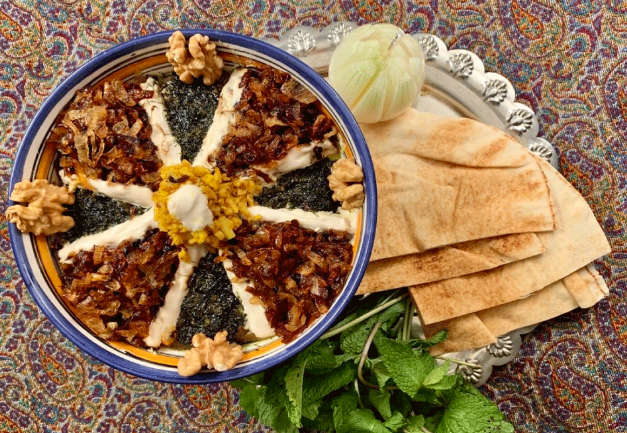How to Prepare Kashke Bademjan + video
Kashke Bademjan (also written as “Kashk-e Bademjan”) is one of the most beloved and quintessential appetizers in Persian cuisine. With its creamy texture and rich flavors, it’s an aromatic eggplant dip that captures the heart of Iranian culinary tradition. Made with roasted eggplants, whey (kashk), sautéed onions, garlic, and mint, it serves as a delightful beginning to any Persian meal.
Ingredients Kashke Bademjan :
- 2 large eggplants
- 1 cup kashk (whey) – If unavailable, Greek yogurt or sour cream can be substituted.
- 2 medium onions, finely sliced
- 4-5 cloves of garlic, minced
- 2 tablespoons dried mint
- 1/4 teaspoon turmeric
- Salt and pepper to taste
- 2-3 tablespoons oil (preferably olive oil)
- Optional: a pinch of saffron dissolved in 1 tablespoon of hot water
- Optional garnish: chopped walnuts and caramelized onions

Steps:
- Prepping the Eggplants:
- Wash the eggplants and pierce them multiple times with a fork to allow steam to escape.
- Roast the eggplants: This can be done in various ways.
- Oven method: Preheat the oven to 400°F (200°C). Place the eggplants on a baking sheet and roast them for 35-45 minutes, turning occasionally until they are soft and the skin is charred.
- Stovetop method: Place the eggplant directly over a gas flame, turning frequently until the skin is charred and the inside is soft.
- Once roasted, let the eggplants cool. Peel off the charred skin and finely chop or mash the flesh. Set aside.
- Onion & Garlic Sauté:
- In a skillet, heat the oil and sauté the sliced onions until they turn golden brown. Take half of the onions out and set them aside for garnish.
- Add the minced garlic to the skillet with the remaining onions. Sauté for an additional 2 minutes.
- Add the turmeric, and give it a quick stir.
- Combine & Cook:
- Add the mashed eggplant to the skillet with the onions and garlic. Cook for 5-7 minutes on medium heat, stirring occasionally.
- Season with salt and pepper.
- Reduce the heat to low, add the kashk (or Greek yogurt/sour cream), and mix well. If the mixture is too thick, you can add a bit of water to reach your desired consistency.
- Final Touches:
- In a separate smaller pan, heat a tablespoon of oil and sauté the dried mint for a minute or two. Be careful not to burn it.
- Mix the sautéed mint into the eggplant and kashk mixture.
- Optionally, add the dissolved saffron for an added layer of flavor and color.
- Serve:
- Transfer the Kashke Bademjan to a serving dish.
- Garnish with the caramelized onions, a few drizzles of kashk or yogurt, and if you like, some chopped walnuts.
- Serve with warm flatbread or naan.
Kashke Bademjan is not just a dip, but a celebration of textures and flavors that takes you on a journey to the heart of Persia with every bite. Whether you’re enjoying it with family or introducing it to friends for the first time, this dish is sure to be a favorite!
here are some expert tips to elevate your dish:
- Quality Eggplants: Select eggplants that are firm to the touch with smooth, shiny skin. These tend to be fresher and have fewer seeds.
- Taste the Kashk: Kashk can be quite salty. Before adding salt to your Kashke Bademjan, taste the kashk to ensure your dip isn’t overly salty.
- Deep Caramelization: Don’t rush the caramelization of the onions. This process brings out the sweetness in onions, adding depth to the dish.
- Texture: While some prefer a smoother, almost pureed texture for Kashke Bademjan, others enjoy a chunkier version. Adjust the mashing of the eggplant to your preferred consistency.
- Balanced Flavors: While garlic and mint are essential, ensure they don’t overpower the delicate flavor of the roasted eggplant. Start with less and add more if needed.
- Heat Factor: For those who enjoy a bit of heat, you can add a finely chopped green chili or a pinch of red chili flakes to the dish.
- Use Fresh Mint: If you have access to fresh mint, lightly frying some leaves in oil can make a fragrant and crispy garnish.
- Let it Rest: If time allows, let the prepared Kashke Bademjan sit for an hour before serving. This resting period allows the flavors to meld together.
- Serving Suggestions: While flatbread is traditional, Kashke Bademjan can also be served with sliced cucumbers, bell pepper strips, or even carrot sticks for a healthier twist.
- Storage: Kashke Bademjan can be refrigerated for up to 3 days. It tastes even better the next day once the flavors have had more time to blend.
- Reviving Leftovers: If your leftover Kashke Bademjan thickens after refrigeration, simply stir in a little warm water or some additional kashk/yogurt to restore its creamy consistency.
- Vegan Version: For a vegan alternative, replace the kashk with vegan yogurt or tahini. Adjust seasonings as needed.
Remember, like all traditional dishes, there are various ways to prepare Kashke Bademjan depending on the region, family traditions, or personal preferences. Don’t hesitate to experiment and make the dish your own!


